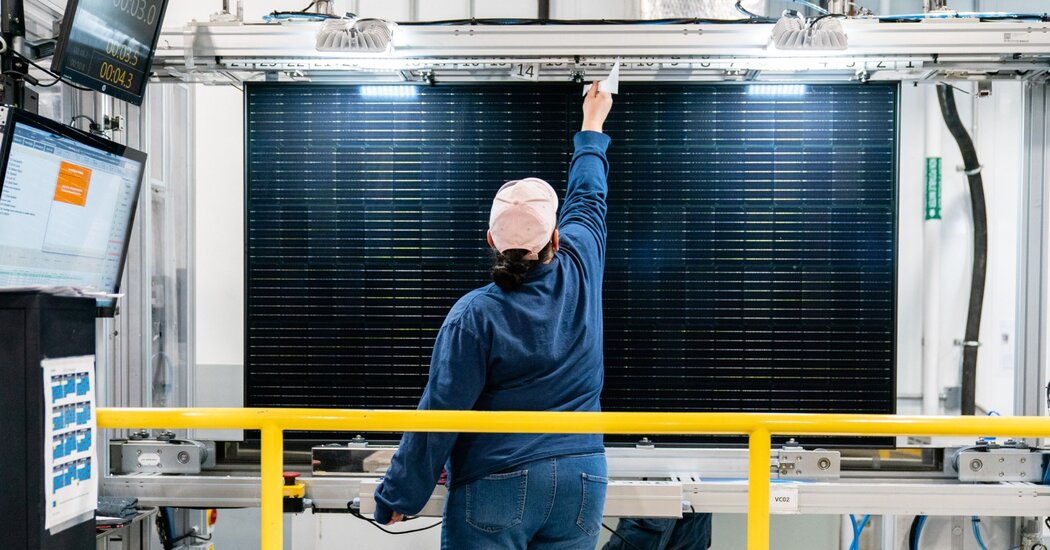The climate and tax bill that President Biden signed in August to increase the use of green energy and electric cars while expanding domestic production seems to be showing some results.
A Korean solar company, Hanwha Qcells, announced on Wednesday that it would spend $2.5 billion to build a major manufacturing complex in Georgia. The factory will produce critical components for solar panels and build complete panels. If realized, the company’s plans could bring part of its solar energy supply chain, which is largely based in China, to the United States.
Qcells, which is headquartered in Seoul, said it made the investment to take advantage of tax credits and other benefits in the Inflation Reduction Act, the law Biden signed into law last summer. The manufacturing facility is expected to create 2,500 jobs in Cartersville, Georgia, about 50 miles northwest of Atlanta. Production is expected to start in 2024.
The company opened its first solar panel production plant in Georgia in 2019 and quickly became one of the largest producers in the US. At the end of last year, it produced 12,000 panels a day. The company said its new facility would increase its capacity to 60,000 panels per day.
“As the demand for clean energy continues to grow nationally, we are poised to employ thousands of people to create fully American-made and sustainable solar energy solutions from raw material to finished panels,” said Justin Lee, CEO of Qcells, in a statement.
The rise of electric vehicles
Georgia Senator Jon Ossoff and the state’s Republican Governor Brian Kemp have aggressively lured renewable energy, battery and auto companies into the state. Several of those investments have come from South Korea, including a planned electric vehicle factory by Hyundai.
“With a focus on innovation and technology, Georgia continues to stand out as the No. 1 state for business,” said Mr. Kemp in a statement.
In 2021, Mr. Ossoff introduced a bill, the Solar Energy Manufacturing for America Act, that would have provided tax breaks for solar energy manufacturers. The bill was later incorporated into the Inflation Reduction Act.
Under the law, companies receive a tax credit at every stage of the supply chain. The law includes an estimated $30 billion in manufacturing tax credits to accelerate the production of solar panels, wind turbines, batteries and for the processing of critical minerals. The law also provides an investment tax credit to companies that build factories that produce electric vehicles, wind turbines and solar panels.
How Times reporters cover politics. We trust our journalists to be independent observers. So while Times employees may vote, they may not support or campaign for candidates or political causes. This includes participating in marches or rallies in support of a movement or giving or raising money for a political candidate or election cause.
Those and other provisions are designed to reduce dependence on China, which dominates the supply chain for crucial raw materials and components for batteries and solar panels. In addition to fears that the United States is losing ground in key technologies, lawmakers are also concerned that some Chinese manufacturers are using forced labor.
“I wrote and passed legislation designed precisely to attract this kind of production,” said Mr. Ossoff in an interview. “It is the largest solar power production in U.S. history coming to Georgia. This economic and geostrategic competition will continue, but my law has put the United States back in the fight to secure our energy independence.”
Legislators and administrations on both sides have long tried to stimulate a domestic solar energy production industry, including by imposing tariffs and other restrictions on imported solar panels. But such efforts have so far yielded only modest results. Most solar panels installed in the United States are imported.
The Qcells project and others could reduce the US dependence on imports, but not quickly. China and other Asian countries have a huge lead in assembling panels and producing the parts that go into them. Governments there have also used subsidies, energy policies, trade agreements and other tactics to help domestic producers.
While the Inflation Reduction Act has stimulated new investment, it has also led to tensions between the Biden administration and allies such as France and South Korea.
For example, the law offers tax credits of up to $7,500 for the purchase of electric cars, but is only available for vehicles made in the United States, Canada and Mexico. Consumers wishing to purchase models from Hyundai and its subsidiary Kia will not be eligible for at least two years until the company’s new Georgia plant begins production in 2025.
Still, energy and auto executives have said the legislation should generally benefit their companies, which struggled to get key parts as the pandemic and Russia’s war in Ukraine devastated global supply chains.
Mike Carr, executive director of the Solar Energy Manufacturers for America Coalition, said he expected more companies to announce plans for new solar equipment manufacturing plants in the United States in the first six months of the year. His group estimates that between 2030 and 2040, US factories will be able to meet all of the country’s demand for solar panels.
“We see this as a very, very big contribution to lower prices in the United States in the medium to longer term,” Mr Carr said, referring to the cost of panels.
Several other solar companies have announced new plants in the US in recent months, including CubicPV, a start-up backed by Bill Gates that plans to begin manufacturing components for solar panels in 2025.
Another company, First Solar, said in August it would build its fourth panel plant in the United States. First Solar plans to invest $1.2 billion to expand its business and add 1,000 jobs.

